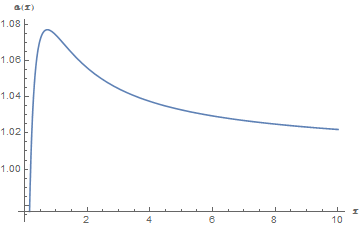$\newcommand{\de}{\delta} \newcommand{\De}{\Delta} \newcommand{\ep}{\epsilon} \newcommand{\ga}{\gamma} \newcommand{\Ga}{\Gamma} \newcommand{\la}{\lambda} \newcommand{\Si}{\Sigma} \renewcommand{\th}{\theta} \newcommand{\R}{\mathbb{R}} \newcommand{\F}{\mathcal{F}} \newcommand{\E}{\operatorname{\mathsf E}} \newcommand{\PP}{\operatorname{\mathsf P}} \newcommand{\ii}[1]{\operatorname{\mathsf I}\{#1\}}$
This answer is based on ideas quite different from those used in my previous answer to this question, and the result is much better. As in that answer, let \begin{equation*} S(x):=\sum_{k=0}^{\infty} \frac{x^k}{(k!)^2}. \end{equation*} Term-wise differentiation shows that \begin{equation*} (xS'(x))'=S(x). \end{equation*} This differential equation can be rewritten as \begin{equation*} 16x^2a''(x)+8x(1+4\sqrt x\,\tanh(2\sqrt x))a'(x)+a(x)=0, \tag{1} \end{equation*} where \begin{equation*} a(x):=S(x)/S_*(x), \end{equation*} \begin{equation*} S_*(x):=\cosh\sqrt{4x}/\sqrt{\pi\sqrt x}\sim e^{\sqrt{4x}}/\sqrt{4\pi\sqrt x}\sim S(x) \end{equation*}\begin{equation*} S_*(x):=\cosh\sqrt{4x}\big/\sqrt{\pi\sqrt x}\sim e^{\sqrt{4x}}\big/\sqrt{4\pi\sqrt x}\sim S(x) \end{equation*} for large $x$, as was noted by Carlo Beenaker.
Note that $a(x)>0$; here and in what follows, for $x>0$. So, by (1), if $a'(x)=0$ impliesfor some $x>0$, then $a''(x)<0$. So, the only local extrema of $a$ are local maxima; therefore and because between any two local maxima there is a local minimum, we see that there is at most one local maximum of $a$ on $(0,\infty)$. Since $a(0+)=0$, $a(1)>1$, and $a(\infty-)=1$, we conclude that $a$ has precisely one local (and hence global) maximum on $(0,\infty)$.
In fact, this maximum occurs at $x=x_*=0.7277\dots$, and $a(x_*)=1.0769\ldots<1.08$. Moreover, $a>1$ on $[0.2,\infty)$. Thus, \begin{equation} S_*<S<1.08\, S_*\quad\text{on }[0.2,\infty). \end{equation}\begin{equation*} S_*<S<1.08\, S_*\quad\text{on }[0.2,\infty). \end{equation*} These facts are illustrated by this graph of the function $a$:
To completely complete this answer, let us verify the mentioned asymptotic equivalence
\begin{equation*}
S(x)\sim\cosh\sqrt{4x}\big/\sqrt{\pi\sqrt x}; \tag{2}
\end{equation*}
here and in what follows, $x\to\infty$.
Let $k_1,k_2,q_1,q_2$ be natural numbers such that
\begin{align*}
&k_1=x^{4/8}-\th x^{3/8},\quad q_1=x^{4/8}-\th x^{3/8}/2,\\
&k_2=x^{4/8}+\th x^{3/8},\quad q_2=x^{4/8}+\th x^{3/8}/2;
\end{align*}
here and elsewhere $\th$ denotes various expressions depending on $x$ (possibly different even in the same formula) such that $\th\to1$.
Write
\begin{equation*}
S(x)=S_1+S_2+S_3,\quad \cosh\sqrt{4x}=T_1+T_2+T_3,
\end{equation*}
where
\begin{equation*}
S_1:=\sum_{k=0}^{k_1-1} \frac{x^k}{(k!)^2},\quad S_2:=\sum_{k=k_1}^{k_2-1} \frac{x^k}{(k!)^2},\quad
S_3:=\sum_{k=k_2}^\infty \frac{x^k}{(k!)^2},
\end{equation*}
\begin{equation*}
T_1:=\sum_{k=0}^{k_1-1} \frac{(4x)^k}{(2k)!},\quad T_2:=\sum_{k=k_1}^{k_2-1} \frac{(4x)^k}{(2k)!},\quad
T_3:=\sum_{k=k_2}^\infty \frac{(4x)^k}{(2k)!},
\end{equation*}
Asymptotic equivalence (2) is an immediate consequence of the following two lemmas.
Lemma 1. $S_1+S_3<<S_2$ and $T_1+T_3<<T_2$; here and elsewhere $A<<B$ means $A/B\to0$.
Lemma 2. $S_2\sim T_2\big/\sqrt{\pi\sqrt x}$.
It remains to prove the lemmas.
Proof of Lemma 1. Let \begin{equation*} M:=M(x):=\max_{k\ge0}b_k,\quad b_k:=\frac{x^k}{(k!)^2},\quad r_k:=\frac{b_k}{b_{k-1}}=\frac{x}{k^2}. \end{equation*} Then $r_k$ is decreasing in $k$, $r_k\ge1$ for $k\le x^{4/8}$ and hence $b_k$ is nondecreasing in $k\le x^{4/8}$, $r_k\le1$ for $k\ge x^{4/8}$ and hence $b_k$ is nonincreasing in $k\ge x^{4/8}$. So, $M=b_{k_*}$ for some natural $k_*=k_*(x)=x^{4/8}+O(1)\in[k_1,k_2-1]$, and so, \begin{equation*} M\le \sum_{k=k_1}^{k_2-1}b_k=S_2. \end{equation*} Next, for $k\ge k_2$, \begin{equation*} b_k=b_{q_2}\prod_{j=q_2+1}^k r_j\le M r_{q_2}^{k-q_2}. \end{equation*} Also, \begin{equation*} r_{q_2}=\frac x{(x^{4/8}+\th x^{3/8}/2)^2}=(1+\th x^{-1/8}/2)^{-2}=1-\th x^{-1/8} \end{equation*} and $k_2-q_2=\th x^{3/8}/2$. So, \begin{multline*} S_3=\sum_{k=k_2}^\infty b_k\le M r_{q_2}^{k_2-q_2}\,\frac1{1-r_{q_2}} \sim M (1-\th x^{-1/8})^{\th x^{3/8}/2}\,x^{1/8} \\ =M \exp\{-\th x^{2/8}/2\}\,x^{1/8}<<M\le S_2. \tag{3} \end{multline*} Further, \begin{equation*} r_{k_1}=\frac x{(x^{4/8}-\th x^{3/8})^2}=(1-\th x^{-1/8})^{-2}=1+2\th x^{-1/8} \end{equation*} and $q_1-k_1=\th x^{3/8}/2$, whence \begin{multline*} b_{k_1}=b_{q_1}\Big/\prod_{j=k_1+1}^{q_1}r_j\le M/r_{k_1}^{q_1-k_1} =M/ (1+2\th x^{-1/8})^{\th x^{3/8}/2} =M /\exp\{\th x^{2/8}\} \end{multline*} and \begin{equation*} S_1=\sum_{k=0}^{k_1-1}b_k\le k_1 b_{k_1}\le x^{4/8}\,M /\exp\{\th x^{2/8}\}<<M\le S_2. \tag{4} \end{equation*} By (3) and (4), $S_1+S_3<<S_2$. That $T_1+T_3<<T_2$ is verified quite similarly; here instead of $r_k=\frac{x}{k^2}$, one will have to use $\frac{4x}{2k(2k-1)}=\frac{x}{k(k-1/2)}$. This completes the proof of Lemma 1. \qed
Proof of Lemma 2. For $k\in[k_1,k_2-1]$, we obviously have $k\sim\sqrt x$. So, using Stirling's formula, it is easy to see that for natural $k\in[k_1,k_2-1]$
\begin{equation*}
\frac{x^k}{(k!)^2}\Big/\frac{(4x)^k}{(2k)!}=\frac{(2k)!}{(k!)^2}\frac1{4^k}\sim\frac1{\sqrt{\pi k}}
\sim\frac1{\sqrt{\pi\sqrt x}}.
\end{equation*}
Now Lemma 2 immediately follows. \qed

